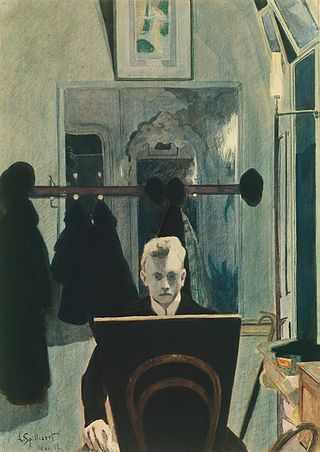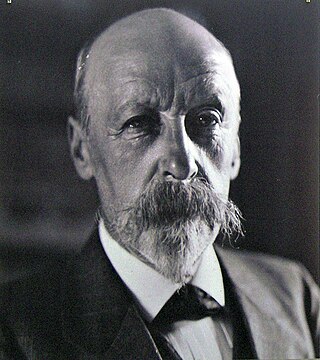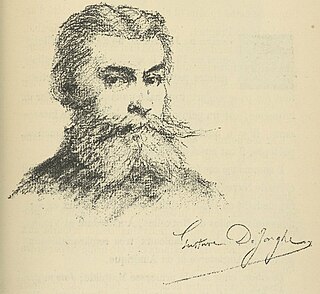
The Musée d'Orsay is a museum in Paris, France, on the Left Bank of the Seine. It is housed in the former Gare d'Orsay, a Beaux-Arts railway station built between 1898 and 1900. The museum holds mainly French art dating from 1848 to 1914, including paintings, sculptures, furniture, and photography. It houses the largest collection of Impressionist and post-Impressionist masterpieces in the world, by painters including Berthe Morisot, Claude Monet, Édouard Manet, Degas, Renoir, Cézanne, Seurat, Sisley, Gauguin, and van Gogh. Many of these works were held at the Galerie nationale du Jeu de Paume prior to the museum's opening in 1986. It is one of the largest art museums in Europe.

Pointillism is a technique of painting in which small, distinct dots of color are applied in patterns to form an image.

Paul Victor Jules Signac was a French Neo-Impressionist painter who, with Georges Seurat, helped develop the artistic technique Pointillism.

Alexandre Cabanel was a French painter. He painted historical, classical and religious subjects in the academic style. He was also well known as a portrait painter. According to Diccionario Enciclopedico Salvat, Cabanel is the best representative of L'art pompier, and was Napoleon III's preferred painter.

Neo-Impressionism is a term coined by French art critic Félix Fénéon in 1886 to describe an art movement founded by Georges Seurat. Seurat's most renowned masterpiece, A Sunday Afternoon on the Island of La Grande Jatte, marked the beginning of this movement when it first made its appearance at an exhibition of the Société des Artistes Indépendants in Paris. Around this time, the peak of France's modern era emerged and many painters were in search of new methods. Followers of Neo-Impressionism, in particular, were drawn to modern urban scenes as well as landscapes and seashores. Science-based interpretation of lines and colors influenced Neo-Impressionists' characterization of their own contemporary art. The Pointillist and Divisionist techniques are often mentioned in this context, because they were the dominant techniques in the beginning of the Neo-Impressionist movement.

Thomas Alexander Harrison, was an American marine painter who spent most of his career in France.

Jean-Jacques Henner was a French painter, noted for his use of sfumato and chiaroscuro in painting nudes, religious subjects and portraits.

Albert Dubois-Pillet was a French Neo-impressionist painter and a career army officer. He was instrumental in the founding of the Société des Artistes Indépendants, and was one of the first artists to embrace Pointillism.

Théophile "Théo" van Rysselberghe was a Belgian neo-impressionist painter, who played a pivotal role in the European art scene at the turn of the twentieth century.

Alfred Émile Léopold Stevens was a Belgian painter, known for his paintings of elegant modern women. In their realistic style and careful finish, his works reveal the influence of 17th-century Dutch genre painting. After gaining attention early in his career with a social realist painting depicting the plight of poor vagrants, he achieved great critical and popular success with his scenes of upper-middle class Parisian life. He tended to use the same models over and over again, and not all of them were aristocratic. "At least three of his frequent models can be identified in the infamous Book of the Courtesans, a top secret leather bound book containing the surveillance files of the Paris vice squad," writes author Summer Brennan.

Léon Spilliaert was a Belgian symbolist painter and graphic artist.

Emile Claus was a Belgian painter.

Hippolyte Petitjean was a French Post-Impressionist painter who practiced the technique of pointillism.
Despite its size, Belgium has a long and distinguished artistic tradition that goes back to the Middle Ages, considerably pre-dating the foundation of the current state in 1830. Art from the areas making up modern Belgium is called in English Netherlandish up to the separation with the Netherlands from 1570 on, and Flemish until the 18th century.

The Angelus is an oil painting by French painter Jean-François Millet, completed between 1857 and 1859.

Gustave Léonard de Jonghe, Gustave Léonard De Jonghe or Gustave de Jonghe was a Flemish painter known for his glamorous society portraits and genre scenes. After training in Brussels, he started out as a painter of historical and religious subjects in a Realist style. After moving to Paris where he spent most of his active career, he became successful with his scenes of glamorous women in richly decorated interiors.
Joseph Édouard Stevens was a Belgian animalier painter and engraver.

Sailboats and Estuary is an oil-on-canvas painting by Belgian srtist Théo van Rysselberghe. Painted around 1887, it shows a coastal landscape elaborated in a Pointillist technique. Van Rysselberghe probably adopted the Pointillist manner after befriending Signac; however, the use of color in Sailboats and Esuary is nonetheless far more realistic than in paintings by Signac and other Neo-Impressionists, and reveals a tendency towards naturalism. The artwork has been in the collection of the Musée d'Orsay in Paris since 1982, on loan from the Louvre.

Alexandre de Latour, or Delatour was a Belgian miniaturist. He also produced a few small format oil paintings.























